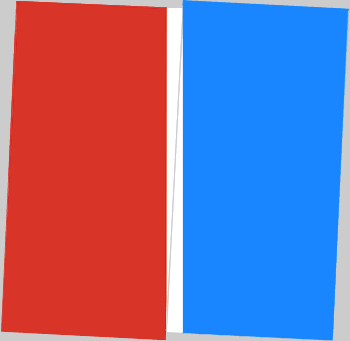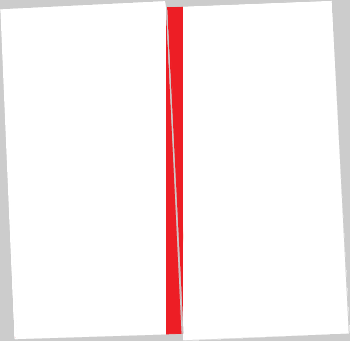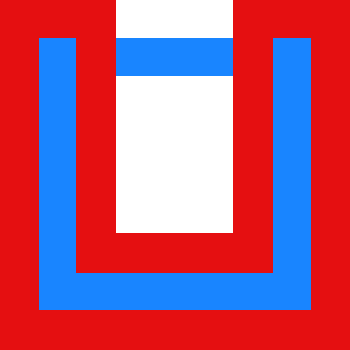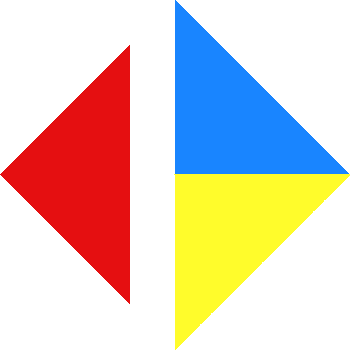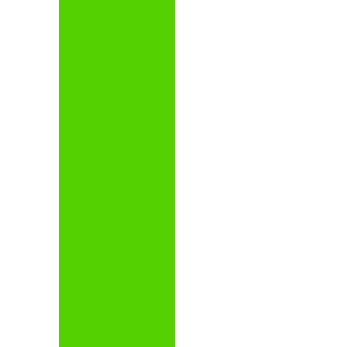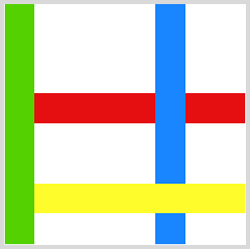Bob Bonies
Elisabeth Grossmann
In the Netherlands constructivist art looks back on a long tradition. The group “de Stijl” originated in the 1920s and in the course of time came to shape the development of constructivist art decisively, so that it is today considered by art critics to be one of the main directions in classical modern art. The creed of the “de Stijl” group still influences art, architecture, and industrial design in the Netherlands today, in that it continues to live as a creative maxim in the aesthetic program “Less is more”.
Bob Bonies can be considered to be a successor of the “de Stijl” movement in as much as he did not just restrict himself to free art alone but extended his artistic work to architecture, industrial design, and art teaching, and exemplified the aim of those pioneers who wanted to use their artistic ideas for shaping their surroundings. Moreover, he can also be considered a pioneer of the second generation, as his constructivist painting imparted a new impetus to the geometric direction of art in the Netherlands of the 1960s.

Were one to look for a conceptual motif in Bonies’ art work, one would in the first instance cite the theory of Josef Albers on “The Unity behind the Many” and “The Many behind the Unity”. His method, however systematic it may be, is directed less towards the programmatic and more towards investigating the potential of variables. Thus Bonies’ art work does not develop in a serial way as is usual in the constructivist domain, but rather in a sequence of cycles of works whose themes recur with varied points of view. The only fixed factor in Bonies’ investigation over many years into color and form is his handling of colors: he has always used and today still uses only four colors, namely the three primary colors red, yellow and blue, the secondary color green (as the complementary color of red) and the noncolor white. On the other hand, he has given the handling of form as well as of format a more open interpretation. His vocabulary of forms includes differently weighted categories of areas with linear edges (stripes of varying thickness, triangles, and rectangles) arranged in the three classical directions horizontal, vertical and diagonal, and has in the last years been extended to include the circle as well as the circular segment. The basic colors and forms appear in different systems of arrangements, of which there are, as regards their number and combination, essentially two types of picture. First there is the closed and contained absolute shape of the square which dominates Bonies’ work and which also occurs standing on a corner (diamond), and then there is, so to speak, the polarly opposed type, the “shaped canvas”, which is sometimes included in the shaping of the picture. This novel shape was developed by American artists during the 1960s and was intended to free them from the traditional rectangular pictorial shape in order to achieve a congruence between picture and format, as well as at the same time attaining an enhanced objectivity.
Were one to seek a common denominator for Bob Bonies’ process of visualization which now encompasses nearly four decades, one would surely find it in the dynamic extension based on a tension-laden balance of forces. Thus, for example, Bob Bonies combines progression with rotational moment in a square format and at the same time quasi extends the construction beyond the boundaries of the picture (Without Title, 1986, p. 22). Or he achieves a displacement of the diagonal axis in a “shaped canvas” by flapping open the upper part of the picture (Without Title, 1987, p. 30). This virulent dynamization of elements has in the last years been further heightened by a return to the method of omission practised in the 1960s (Without Title, 1966, p. 19) or the inclusion of the circular segment (Without Title, 2002, p. 29). In the multipartitioned pictures, several parts constituting the whole are omitted, leaving the completion of the gaps to the imagination (Without Title, 2003, p. 42). Furthermore, the basic system of proportional partitioning in the multipartitioned picture is now harder to comprehend. Thus, in recent years his intention has distanced itself from the initial elementary order and has proceeded in the direction of increased complexity, without, however, renouncing his reductionist convictions. The pictorial organization continues to be based on the interpretation of progression, rotation, displacement of axes and omission, but the extensive character of the most recent works is more strongly accentuated.

In view of the prevailing social background, it is not difficult to interpret this tendency to break through the boundaries as a characteristic of Bonies’ democratic understanding of art and his typical open-mindedness. Willy Rotzler has used the medium of sailing to describe Bonies’ work. He considers his works to be “sheer as a sail, reduced to minimal essentials”, and they suggest “a dry cheerfulness and distant vision, as is typical of a coastal, seafaring people” (Rotzler, Willy: Bob Bonies und Nelly Rudin. In: Zwei Künstler aus zwei Ländern – Nelly Rudin, Bob Bonies. Zuger Kunstgesellschaft (ed.), 1989). Bonies’ paintings appear cheerful and composed, inspired by the pioneering spirit of the 1960s, as if the artist were at all times prepared to send his pictorial intentions across the seven seas.
Preface
Bob Bonies has, with his particular form of art, taken up a direction which can be considered to be a successor to the de Stijl movement. His works are a continuation and development of the principles of this art form which originated in the Netherlands. He has extended the strict reduction to the three basic colours by including green in his large works. Not only in this way, however, but also in formal ways has he endeavored to shift the boundaries of his preceding generation. He paints segments of circles which he combines with strictly rectangular shapes. Bob Bonies is an impassioned innovator. Thus he demonstrates through his art, which has connections with hard-edge painting as well as with the classical shaped canvases, that a composition constructed solely according to aesthetic criteria loses nothing in the way of relevance or freshness.
Formally, Bob Bonies is interested in the phenomenon of movement. This he achieves not only by juxtaposing the three basic colours with green, leading to a differentiated sense of depth, but also by placing the different shapes and forms in an irritating way relative to one another within the picture. These subtle effects help to demonstrate to the viewer how sensitive his spatial perception is.
It is a pleasure for us to extend our hearty thanks to Bob Bonies for his dedicated help. It was not only his “Haagse Hopjes” but also his honest enthusiasm for this exhibition which made the preparations really enjoyable. We also thank Naomi Duveen, who accompanied the preparations with many good proposals and suggestions. Our sincere thanks are due to Dr. Elisabeth Grossmann, director of the “Haus Konstruktiv” in Zurich and a friend of the Arithmeum from the beginning, who has agreed to contribute an article to this catalogue and to speak at the opening.
As always, we are especially grateful to our sponsors, without whose continued support this exhibition would not have been possible.
Biography
1937
Born in The Hague.
1960
After five years of professional art courses in The Hague and Stockholm, he has his first exhibition in 1960 at the Observatorium Gallery in Stockholm. During these years he frequently meets with Olle Baertling. At the end of this period he establishes his studio in The Hague.
1962/63
Visits the United States and Canada, where he paints abstractly. He marries Hanneke Schuitema there.
1964
He settles in Wassenaar near The Hague.
1964/65
Once back in the Netherlands, the development of his work is characterized by a continued reduction of pictorial elements, forms, and colours. He not only paints, but also constructs reliefs and spatial structures out of fibreglass and aluminium as multiples (“art for the people”).
1965
He joins the “Bond voor Beeldende Kunstenaars” (BBK).
1966
He became board member of the BBK.
1965/66
Marks the beginning of fifteen years of cooperation with Riekje Swart of the Swart Gallery in Amsterdam.
1966
First one-person exhibition in the Stedelijk Museum, Amsterdam. Participates in the international exhibition “Forms of Colors” in Amsterdam, Berne and Stuttgart, with Albers, Bill, Judd, Kelly, Lohse, Newmann and Stella, among others.
1967
First meeting with Richard Paul Lohse in his studio.
1969
Cooperates with choreographer Hans van Manen to create the ballet “Squares”, the pre- mière of which was performed by the “Nederlands Dans Theater” in the “Théatre de la Ville”, Paris.
1971
One-person show at Galerie Teufel, Koblenz.
1972
Cofounder of the trade union “Bond voor Beeldende Kunstarbeiders (BBKA)”, whose chairman he becomes.
1972 onwards
Is active as member of various consulting bodies among others of the ministry of cultural affairs concerned with the integration of the plastic arts, architecture, and municipal planning.
1972 onwards
Realization of numerous commissions in public buildings.
1976
One-person show at Galerie Teufel, Cologne.
1979
One-person exhibition in the Gemeente Museum in The Hague with “shapes” and constructions.
1981
Retrospective exhibition in the Van Abbe Museum in Eindhoven.
1981 – 1988
Worked with the dancer Naomi Duveen to produce several different performances with the overall title “Danswerk”.
1988 – 2001
Director of the Free Academy of Fine Arts in The Hague.
1989
Together with the couturier Frans Molenaar and the composer Simeon ten Holt, he realizes the “Constructivistic Triptych” which is exhibited in Utrecht and Tokyo.
1991 onwards
Visits the United States annually to work there. He stays, in particular, in New York, Marfa (Texas, Donald Judd), and Taos (New Mexico, Agnes Martin).
1991
Comprehensive exhibition entitled “Bob Bonies, Works from the Years 1965-1991”, in the Hoffmann Gallery, Friedberg.
1993
Marries Naomi Duveen.
1999
Invitation to participate in “The Quindao International Art Exhibition” held in the Municipal Museum in Quindao, China.
2001
Rehearsal of the ballet “Squares” by Introdans, Arnhem.
2001 onwards
After retiring from the directorship of the Free Academy of Fine Arts in The Hague, he once again devotes himself fully to his own artistic work.
Bob Bonies in Conversation
How did you discover art for yourself? When did you decide to become an artist?
I began to find art exciting somewhere back in the middle of the 1950s. I was at middle school at the time – without much success, to be honest. Thus the question arose as to whether I would be better off learning something practical. My father was a photographer, and so it was only natural to consider whether that might be something for me, too, or perhaps interior designing or decorating. So I started at the Academy of Art when I was only sixteen years old. The director, an artist himself, said to me: “Oh well, now you’re here we’ll start you off learning to draw”. At that time the drawing classes were naturally traditional – we sketched models realistically. I worked very enthusiastically, which my parents noticed, and eventually they said: “If you want to continue doing this, then we’ll support you”. So I stayed at the “Vrije Academie voor Beeldende Kunst”. After that I studied for some time at the Royal Academy in The Hague, where I concentrated on sculpture. That, too, was handled completely traditionally, figuratively. My interests were, however, wider than that. I was also interested in interior layout and design. So I then went to the “Konstfackskolan” in Stockholm, which is a college for arts and crafts. It was there that I first became aware of Olle Baertling’s work, which impressed me deeply at the time. I often returned to Stockholm, right into the 1960s, and on this foundation I then decided to become a professional artist.
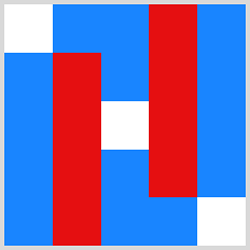
Where was your first exhibition?
My first exhibition was in 1960 at the end of my training in Stockholm. I then returned to the Netherlands, where I have lived and worked as an artist ever since.
Was it very difficult to get going as a young artist? How did you orientate yourself in those days?
The first years were naturally very hard. In those days I was doing abstract painting and sculpture, lyrically abstract. In the Netherlands, COBRA was all the rage as modern art, for example Karel Appel, but I had a different idea of art. In 1963 I visited America and there I saw a totally different form of art, one not normally seen in Europe. This visit certainly influenced my work, which underwent a large reduction in style in the space of three or four years.
Were there any artists in those days on whom you modelled yourself?
There were such artists, American ones. When I was in America, I lived for a while in Washington D.C. It was there that I got to know Morris Louis and Kenneth Noland. Another such artist was Clyfford Still whom I very much admire. I consider him to be an absolutely top painter. When looking at a painting by Clyfford Still, it is difficult to explain why I feel such an affinity for his work, but I do and have done for many years.
Do you think that your roots have something to do with the direction of art which you have chosen?
I am from The Hague, I was born there. The Gemeentemuseum in The Hague has the most extensive collection of Mondrian’s works in the world. I was always very interested in the de Stijl movement. I studied the works of Theo van Doesburg, Mondrian, and all the others with great interest. That was always part of my baggage, as it were, wherever I went. But at the time I had no idea that I would go in that direction myself.
What else appealed to you apart from the de Stijl movement? What else contributed to your development of form and colour?
I was extremely interested in the development of modern art in Russia: Malevich, Tatlin, and Lissitzky. The connection between de Stijl and Malevich and the Russian artists at the beginning of the 20th century, as well as the freedom and breadth of the American avantgarde, were the three main roots from which my further development sprang. Thus one can, I think, see today, that my work is partially the continuation of a certain European tradition and at the same time also has a certain connection with America. In this sense I am, after all, a loner, as I have always been in the Netherlands.
Your particular form of art sprang from these roots, but surely also from modern ones?
Yes, also from modern ones, but on the other hand, from the American standpoint one perceives the European traditions. That’s what makes my work different.
Can you say something about the development of the pictorial language of your pictures?
That was a long path over a period of forty years, concentrating on the question as to how far one can go with restrictions and reductions without losing all the tension in the picture. Today, I don’t need to start from the beginning every morning. My work now has a large, firm basis. With every completed painting one gains in experience, which one can then invest in the next one. I now feel completely at home in my work. I don’t need new inspiration every single day. What is essential for me is not to lose track and go astray, but to follow and deepen my path consistently. I need to be convinced of my own work and have full confidence in it.
In constructivist art, and also in your work, what matters in the end is the picture itself. The creative process plays only a minor role as no expressive strokes of the brush are involved. Can you imagine your works of art being created by some other media rather than by painting, or would that entail the loss of some essential element?
In constructivist and also in concrete art the restrictions of the media used must be concentrated totally differently. The more sparse and restricted the media become, the more difficult it is to work. You can, for example, see that clearly in Chinese and Japanese calligraphy, from which one can learn a great deal.
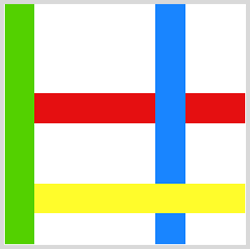
The original idea of constructivist art was to induce people to see the world around them in a new way, to integrate art into their lives. To what extent do you think this has been achieved so far?
In the middle of the 1960s I established my own studio near The Hague, and I also intended to become engaged politically. I was filled with the idea that art was for everybody. “Everybody is an artist”, Beuys once said. I found this idea fascinating, but who wants to be an artist? On the other hand, I still believe in the goals of constructivist art. The constructivist artist wants to open a door for people to enter through, or a window for people to look through in order to see a different kind of reality. I believe that is the purpose of the artist and his art. For me, constructivism as a concept is still highly topical, especially in this visual era with its enormous two-dimensional visual flood through television and advertising. I think it is very important that something with a deeper quality is available. That is why I believe that artists have a definite and proper place in society today, as they have always had in the past.
By what criteria do you judge whether one of your pictures has turned out to be good? Does it ever happen that you paint a picture which you liked when you sketched it but which doesn’t satisfy you when it is finished?
Yes, that could happen. But with my way of working I am given several chances to judge my work. I have a lot of experience with the form and effect of colours and with judging the quality and quantity of colour. I also have a lot of experience with questions of format. My first sketches are small and also large, then I make prototypes and at the very end I decide on the actual format and paint the picture one-to-one.
You have restricted yourself not only in your pictorial language, but also in your choice of colours. Does it ever happen that you wake up in the morning and say to yourself: today I want to paint in purple, or in orange?
Neej, neej, neej, I haven’t done that for decades. Since the 1960s I haven’t painted in a subjectively colouristic way. I use colour for contrast, for perceiving forms. Different colours act differently in the way they form contrasts: red is the number one and blue is its main contrasting colour, then comes yellow and finally, in contrast to red, there is the fourth colour green. I have in the past never used more than four colours. Each of these I also use for a special direction in space: vertical, horizontal, diagonal. In my paintings I aim to achieve a synergy between the three-dimensionality or the construction of my picture on the one hand, and the real space in which the picture exists on the other. This correspondence between pictorial space and surrounding space is what makes up the actual quality of the picture. In this sense I also see myself as a spatial constructor. For forty years now, I have been using only the primary colours plus green and white. The same goes for forms. Only now am I actively using compasses again, something I have hardly done in the last twenty years, during which I worked mainly with squares and rectangles. I am now connecting up with the past again, not only with respect to compasses. When one considers the essence of the picture and concentrates the possibilities, then one needs no more but fewer means. In this sense I also feel a great affinity for Ad Reinhardt or Agnes Martin.
What they express in their pictures is not usually so direct. Your paintings are quite different – they are utterly direct on account of the clarity of their colours and forms.
Certainly my pictures express themselves more directly. When one studies them, one doesn’t immediately feel compelled to look for a psychological meaning, or for a particular experience, as one would with artists who choose their colours subjectively.
In spite of the clear directness of your paintings, do you not sometimes want to reach the viewer emotionally, or is that completely impossible with your paintings?
No, that is not impossible. Just as it isn’t impossible for me to paint an emotional picture. There is an emotional component in me too, namely, when I decide when it is enough. Then I find that it can’t be less either. Thus there is always also a subjective component. And it has to be like that, that is typical, that’s what art and artists are all about.
By what criteria can one judge the quality of works of constructivist artists?
Today the category of constructivist art is rather wider than it used to be. Often concrete art is also included. When painting, I proceed very systematically, but the pictorial quality is of more importance to me than the programme. That is the main difference. There are several different birds in the constructivist tree and each one sings its own song. It is difficult to say in general what constitutes a good piece of art. One must judge from a historical perspective. If, for example, one looks at the works of Robert Mangold with their picturesque surface, then that is somewhat irritating. On the one hand this has something to do with the constructivist conception of the picture, and on the other it is cosmetic, with an awfully false romanticism. But when one considers his development, then one must agree that he deserves the position that he holds. He has crossed certain boundaries. One can honestly say that his is a very comprehensible and good form of art.
How do you proceed in detail when you begin a new painting?
When I now set to work in my studio, I proceed completely traditionally: canvas on dovetailed wooden frame. I usually paint with a brush, that is quick and efficient.
So your skill with the brush still plays a role in the creative process?
Not as a means to an end. In my work manual skill is not strictly necessary in order to achieve my aim. But the direct contact with what is being represented is certainly necessary, with the result that there are little nuances in the use of colours – not colours as colours but as matter. Colour saturation plays a decisive role. I can’t leave that to anyone else. Or perhaps I could, but I don’t want to. That remains an essential point. When one judges the end result, then one can also perceive this, one experiences it. Colour quantity always also influences colour quality, and this constitutes a subjective component of the judgment of the picture. I like to be in control here. In this way I am thus also a colourist.
With regard to your work “Kunst am Bau”, what was your artistic relationship to architecture?
Whenever I was commissioned to do such a project, I had the chance to work together with people of other disciplines. We always strived for a synthesis. I was involved in an interdisciplinary team comprising a constructor, an architect, and an artist. That was really exciting. Of course, as an autonomous artist I always had to restrain myself a bit.
Were you also able to contribute as an artist outside your own studio?
From 1988 to 2001 I was director of the Vrije Academie in The Hague. That is a totally different facet in the life of an artist. For many years I was also a consultant for art projects in the Netherlands, and was responsible for all commissions. Seen as a whole, one can certainly say that I did not spend all my time in my studio. I think it’s important for an artist to orientate himself more broadly and not to spend all his time with brush and palette in his studio.
When you were director of the Academy, did you try to convert the students to your ideas?
No, never. It is very important that each one of them follows their own path and discovers art in their own way. I have never ever tried to impose my own conception of art on others because I know, that is fruitless. Students who are receptive for that sort of influence soon become passive, or imitators.
Can one really learn art at an art academy?
It is practically impossible to learn art, but one can create a climate or offer an environment which one hopes will inspire young students. In the end, however, each one of them must make their own way as an artist. And that’s not too much to expect. Of course, one can act as an example as well, one can show them that it is worth while to persevere and not to let oneself be led astray too easily, which unfortunately often happens. Selling pictures, following trends and fashions, and the promise of quick success all play a role. In this sense real art is something quite different. Quick success doesn’t exist here.
Of course, the question always remains whether quick success is also lasting success.
That is indeed always the question these days. When one is a professional artist, then one becomes part of a system with all its associated marketing. In the fine arts, quick success is usually strived for, especially by the non-artists involved, who want to become rich quickly. One should really try to stay clear of that environment as much as possible.
How do you recognize lasting values in constructivist art? Do you find in your own work that you painted something thirty years ago which you still like just as much today?
Naturally not everything is always as good today as it was thirty years ago. But at the same time one can realize that it was necessary to paint a certain picture at that time in order to go a step forward. There are long lines and also short moments, and both should be judged in concert, and at the end one can say that this is a good artist and another perhaps a not so good one.
But usually every artist will assert to be a good one!
Yes. One tries to go a step forward every day, or at least as often as possible. But one cannot always produce top quality work.
Have you ever destroyed a picture, or thrown it away, or at least placed it in a corner?
No, or nearly so. There are pictures which I hardly ever look at, and others which I enjoy hanging in my rooms. But that’s the same with every artist. And moreover, different viewing times make different judgments possible. There are certain periods when I love Mondrian’s pictures, and others when I say that I have painted much better ones myself. Things are not static, they are dynamic, and the same holds when judging one’s own pictures.
Is there nothing, then, that you consider to have really lasting value as a work of art?
Naturally, I have several icons or experiences tucked away in my mind, of which I say that they have a constant quality for me. Brancusi’s sculptures, for example, and some of Mondrian’s pictures. They will last. Then there are also some pictures of Malevich from the 1920s. Several pictures from that period are the absoplute pinnacle for me.
Artwork









